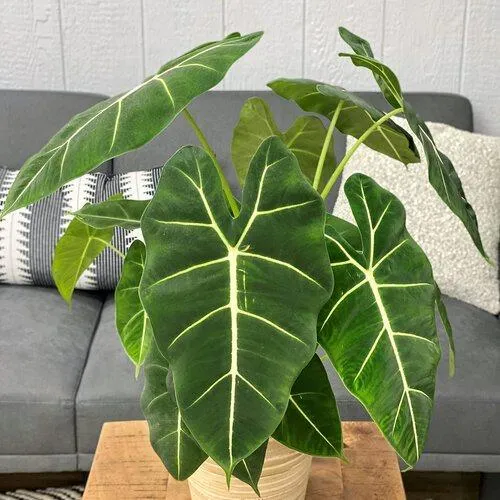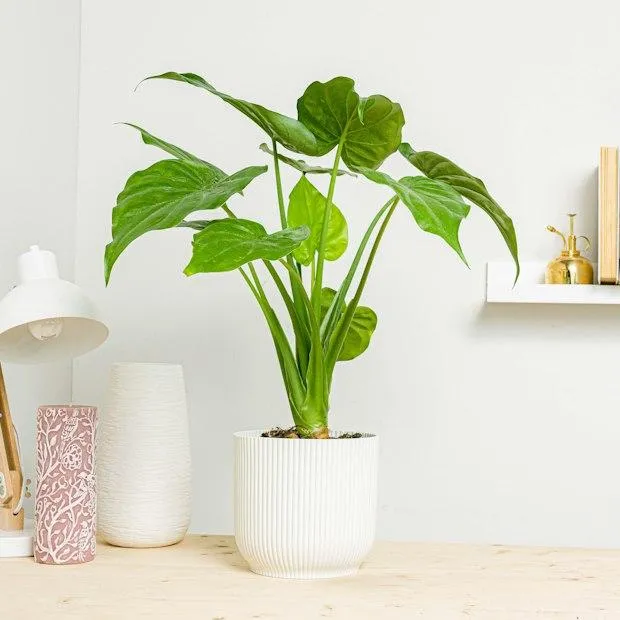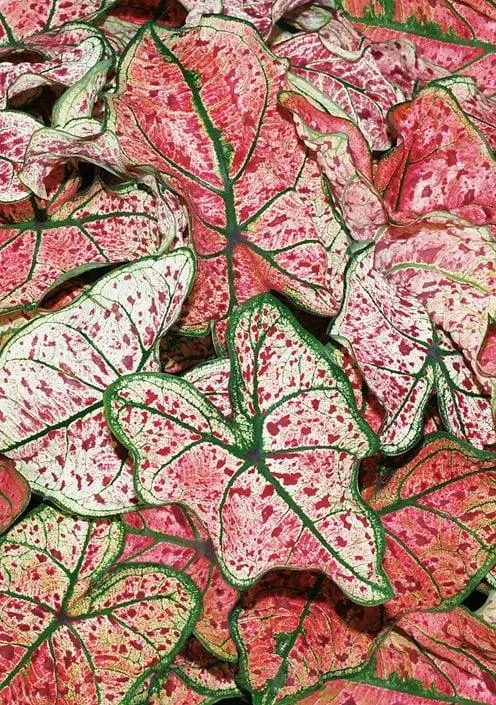Understanding the Relationship Between Alocasia Plants and Cats
If you searched for “alocasia cats”, you likely had questions about whether these tropical plants are safe for cats or not. Rest assured, this article will cover all aspects of the alocasia-cat dynamic from a cat owner’s perspective.
Are Alocasia Plants Toxic to Cats?
The short answer is yes – alocasia plants, which are members of the Araceae family, can be toxic when ingested by cats. Their sap contains calcium oxalate crystals that can cause oral irritation and potentially esophagus or intestinal issues if eaten.
From my experience as a long-time cat owner, it’s pretty common for curious cats to taste new plants just by accident. The problem with alocasia is those tiny crystals can be incredibly irritating to a cat’s delicate mouth tissues. Symptoms of toxicity may include drooling, vomiting, difficulty swallowing, and loss of appetite.
In rare cases of large ingestions, alocasia sap could damage the kidneys. So it’s best to consider them high-risk for cats and kittens who love to nibble on houseplants.
Signs Your Cat May Have Eaten Part of an Alocasia Plant
If you notice any of the following after your cat had access to an alocasia, it’s a good idea to contact your vet:

- Drooling or pawing at the mouth
- Vomiting
- Difficulty or pain when swallowing
- Loss of appetite
- Eye swelling
- Difficulty breathing
While poisoning is unlikely from minor contact, it’s still best to monitor your cat closely and look for signs of distress. Your vet can examine the mouth and provide supportive care if symptoms persist or worsen.
How to Cat-Proof Alocasia Plants
If you want to keep your beautiful alocasia where your cat has access, a few precautions will help ensure no accidental mishaps occur:
- Place the pot up high, out of jumping/clawing reach on a tall shelf or bookshelf.
- Use top-heavy pots without drainage holes on the bottom to prevent knocking it over.
- Coat the soil surface with sticky substances like pet-friendly floral spray to deter digging.
- Place the pot inside a mesh cage or behind an inexpensive baby gate.
- Trim away any droopy or dangling leaves within easy nibbling range.
I’ve also found that regularly distracting my cat with toys and playtime helps curb its plant curiosity overall. The goal is to nip any interaction in the bud.
Alternative “Cat-Safe” Houseplants
If the alocasia is too much of a risk despite precautions, here are some lower-risk alternatives to consider:
- Peace lily – toxic in large doses but rarely causes issues
- Spider plant – non-toxic fronds are seen as an invitation to play by some cats
- English ivy – slightly toxic but usually ignored by cats
- Pothos – non-toxic vines are Virtually impossible for a nibbling cat to resist
- Snake plant – toxins make it unappetizing to cats
Cacti and succulents are also generally considered low-risk. So with some trial and error, you should be able to keep vibrant houseplants and a curious feline friend happy.

What to Do If Your Cat Does Eat Part of an Alocasia
If kitty gets to an alocasia despite efforts, don’t panic. Remain calm and:
- Gently wipe out the mouth with a warm, damp cloth to remove any remaining plant material.
- Call your vet right away for advice, especially if any symptoms appear.
- Induce vomiting only if your vet recommends and you can do so safely at home.
- Watch the cat closely and note any changes in behavior, appetite, etc.
- Prepare to transport to the vet if symptoms worsen so they can monitor and provide supportive care.
Most cases resolve with just observation, but it’s best to get expert guidance as a precaution. The key is acting quickly if ingestion occurs.
Final Thoughts on Owning Alocasias With Cats
To summarize, alocasia plants present some risks to feline friends due to their natural calcium oxalate crystals. But with proper precautions like securing pots high up, deterring digging in soil, and providing alternative chew toys – it’s possible to keep the plant around as a decorative fixture.
Overall cat safety should be the top priority over any houseplant. So if there’s too much uncertainty, it’s best to simply choose another variety that poses fewer dangers to an inquisitive kitty companion. Your cat’s well-being comes before plant aesthetics every time.
I hope this overview helped address all the potential concerns behind having alocasias and cats coexist safely in the home. Let me know if any part of the relationship needs more clarification!

“Alocasia Care Requirements”
| Light | Bright, indirect light. Will tolerate low light but may grow leggy. |
| Soil | Well-draining potting mix. Allow to dry out between waterings. |
| Water | Water when top inch of soil is dry. May need less in winter. Don’t let sit in water. |
| Humidity | Prefers humid conditions. Mist leaves regularly or use pebble trays. |
| Fertilizer | Feed monthly in spring and summer with diluted liquid fertilizer. |
| Temperature | Grow between 65-85°F. May drop leaves below 60°F but tolerate 50s. |
| Pests | Check for spider mites or mealybugs. Treat with insecticide as needed. |
FAQ
-
What is an alocasia cat?
An alocasia cat is basically a type of houseplant with large arrowhead-shaped leaves. It’s sometime called an elephant ear plant since its foliage seems like giant elephant ears. Alocasia cats come in different varieties with leaves that may be green, red or spotted.
-
Do alocasia cats need special care?
While alocasia cats are fairly easygoing plants, they do need some TLC to stay healthy. They like moist but well-draining soil and prefer humidity around 50%. Keep them out of direct sun cause too much rays might scorch the leaves. You’ll also wanna wipe down the leaves every now and then to prevent dust buildup. Overall, as long as you water and clean them regularly, these leafy guys should be pretty low maintenance.
-
Are alocasia cats poisonous?
Believe it or not, most parts of the alocasia cat plant contain calcium oxalate crystals which can cause irritation if eaten. While their toxicity is considered mild, it’s still best to keep these plants out of reach from little kids and pets. You especially wanna make sure nobody nibbles on the leaves or chomps down on any bulbs. Even a tough guy like Godzilla might feel a bit queasy after munching on an alocasia cat.
-
What kind of environment do they need?
To truly thrive rather than just survive, these elegant leafy beasts need tropical or subtropical conditions similar to their natural habitat. Alocasia cats like temperatures around 70-80 degrees F and high humidity around 50-60%. They will also need lots of bright, indirect sunlight. However, they can tolerate low-light conditions for limited periods. Providing the right growing space will help these amazing plants look their very best.
-
How fast do they grow?
The speed at which alocasia cats grow basically depends on numerous factors like drainage, nutrients and lighting. Under ideal conditions, you might notice new leaves unfurling every month or two during the spring and summer. While growth may seem a bit sluggish in fall and winter. With fertile soil and sufficient water, some varieties can put out 2-3 large leaves at once! Therefore, these dramatic divas have the potential to transform a space pretty quickly if their needs are met.

